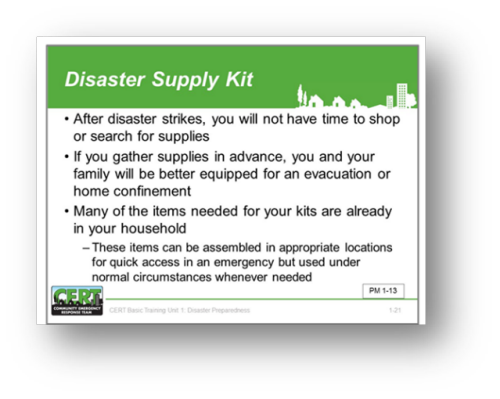Step 3 - Build A Kit

Since you do not know where you will be when an emergency occurs, prepare supplies for home, work, and vehicles.
• Home: Your disaster supplies kit should contain essential food, water, and supplies to last at least three days. Keep this kit in a designated place and have it ready in case you have to leave your home quickly. Make sure all family members know where the kit is kept. Additionally, you may want to consider having supplies for sheltering at home for up to two weeks.
• Work: This kit should be in one container, and ready to “grab and go” in case you are evacuated from your workplace. Make sure you have food and water in the kit. Also, be sure to have comfortable walking shoes at your workplace in case an evacuation requires walking long distances.
• Vehicle: In case you are stranded, keep a kit of emergency supplies in your car. This kit should contain at a minimum food, water, first aid supplies, flares, jumper cables, and seasonal supplies.
How To Prepare Your Disaster Supply Go-Kit:
1. If you have only 5 minutes to evacuate, do you know what you will take with you? Project S.P.E. has plans and resources to help you pack like a pro. ( Project S.P.E. is a commercial site. No endorsement implied).
2. To create a Go-Kit ,review sample checklists online from disaster services organizations.
3. Gather the supplies you need from checklists. Remember that many of the items needed for your kits are already in your household. It is possible to assemble these items in appropriate locations for quick access in an emergency and use under normal circumstances, whenever needed.
4. Always place the supplies you are likely to need for an evacuation in an easy-to-carry container or bag.
5. The kit should, at a minimum, include basic disaster supplies:
• Water (store at least one gallon of water per person per day for two-weeks)
• Food (store at least a two-week supply of non-perishable food)
• Medications (prescription or over the counter medicines as needed)
• Flashlight and spare batteries
• First aid kit (fully stocked)
• Moist towelettes
• Blanket(s)
• Duct tape
• Battery operated radio and spare batteries
• Cell phone with charger (invertor or solar)
• Manual can opener
• Sharp knife or scissors
• Tools such as wrenches or pliers
• Personal items and other supplies
6. Remember to maintain the kit by checking or changing batteries as needed, checking expiration dates on water/food items, and restocking the first aid kit as necessary.
Pets and Emergency Kits
Don't forget your Pets when packing your emergency kit. For more tips, visit http://ready.gov/animals. For a Pet Go-Kit, consider including:
🐶 Pet medications and copies of their medical records,
🐱 A photo of you and your pet together for later identification,
🐰 Pet carriers and leashes,
🐭Food, treats, and toys.